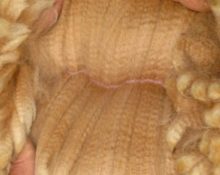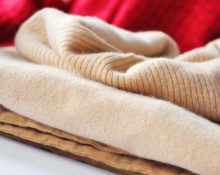 The very name Soviet Merino suggests that this breed was successfully bred during the Soviet period in the first half of the 20th century thanks to the long-term crossing of sheep (stavropol coarse wool) with rams (fine wool Altai). The work of the breeders was to ultimately obtain such an ideal breed that would combine high-quality wool and the ability to produce a large amount of meat.
The very name Soviet Merino suggests that this breed was successfully bred during the Soviet period in the first half of the 20th century thanks to the long-term crossing of sheep (stavropol coarse wool) with rams (fine wool Altai). The work of the breeders was to ultimately obtain such an ideal breed that would combine high-quality wool and the ability to produce a large amount of meat.
Today it is customary to distinguish two main types: wool meat and wool. The main difference between the latter is that the dimensions are slightly smaller, but the amount of wool obtained is slightly higher.
Reference! Soviet merino wool is much finer than human hair, so the name fine-fleece fully justifies this feature.
If we compare Soviet merino with other types, we can highlight the following distinctive features: a more powerful and stronger constitution (the weight of a sheep reaches one hundred kilograms, and a ram about one hundred and fifteen), the body is built proportionally, the presence of specific several transverse folds on the neck, the color of the fleece is usually white (there are also specimens of gray, beige and yellowish shades), and its length reaches up to nine centimeters.
Almost the entire surface consists of fur, even the head (except for the nose and eyes). The wool is so thick and lush that it gives the impression that merino looks like a ball. The older the animal gets, the longer its fur grows.
Reference! The breeding zone in large and small farms covers the territory of the plains of the Altai Territory, the steppes of the North Caucasus, the pastures of the Stavropol region, the open spaces of Kalmykia and many other regions of our country that have a suitable climate for breeding.
Breed characteristics
 The main advantages include the rapid rate of weight gain due to the balanced consumption of fresh grass, root vegetables (carrots, turnips) and special feed rich in vitamins and minerals (bran) in the summer. Due to this, the skin and bones are very well developed. It is quite easy to create housing conditions: merino sheep graze in groups in almost any weather, even with strong winds (with the exception of rain) almost from morning to evening.
The main advantages include the rapid rate of weight gain due to the balanced consumption of fresh grass, root vegetables (carrots, turnips) and special feed rich in vitamins and minerals (bran) in the summer. Due to this, the skin and bones are very well developed. It is quite easy to create housing conditions: merino sheep graze in groups in almost any weather, even with strong winds (with the exception of rain) almost from morning to evening.
Important! Sunbathing and fresh air are an excellent prevention of the appearance of harmful parasites.
It is worth noting that merino sheep can easily tolerate cold winters. Another advantage is the high fertility and caring attitude of the sheep towards its offspring, which is especially suitable for breeders.
Important! The main disadvantage is the frequent contamination of the fleece due to the low grease content.You can also find animals with insufficient thickness of cover, located especially on the back.
Wool characteristics
 The demand and popularity of fine merino wool is explained by its unsurpassed high quality and excellent properties, such as softness, the ability to absorb moisture and create warm and cozy things from this raw material (thermoregulation function). Therefore, this species is the most common for breeding in our country.
The demand and popularity of fine merino wool is explained by its unsurpassed high quality and excellent properties, such as softness, the ability to absorb moisture and create warm and cozy things from this raw material (thermoregulation function). Therefore, this species is the most common for breeding in our country.
It is worth noting that the cover is cut as a whole cloth, from which a soft fabric is subsequently produced that is very pleasant to the body, environmentally friendly, hypoallergenic and quite easy to care for. The areas of use are varied: clothing for adults and children (thermal underwear), as insulation for winter shoes, blankets, rugs and much more. Things will last a long time due to the elasticity of wool.


 1
1




